in Each of Us

Back to the top
Comments

|
This is a preliminary website to accompany the book The Scientist in Each of Us. The book can be thought of as an elaboration on the following statement from Albert Einstein: The book is in search of a publisher. Currently this page is only a placeholder for supplementary information referred to in the book. It is meant only for reviewers as I work on the book. Here is a brief summary of each chapter:
There are a few major sections to this page, and they are all based on the book. First, some of the experiments from the book are best shown in videos, or contain too much detail for the book. So I've put them in the sections shown here: Second, the book discusses references to resources on reasoning. That is given here: Third, there is only so much room in a book for endnotes. I like endnotes, and I'd like to get carried away. This web page allows me to do that. Those notes are here: Finally, if you would like to leave a comment, you can do so here: |
|
Chapter 2 of The Scientist in Each of Us walks through a series of experiments, mistakes and all, based on an observation that when I connected a springy and free-to-move coil of wire to a battery, the wires seemed to bunch together. I tidied up that clumsy sentence into a nice little 'observation of a phenomena' statement: After making that observation I chose to forge, for the purposes of the book, all the science we already know about this phenomena. I was free to speculate wildly for an explanation. Each explanation will be a hypothesis. I'm not claiming I thought of everything, but here is my list from the book of possible explanations: The "H" stands for "Hypothesis". Read Hmagnetic as "H sub magnetic" or as "the magnetic hypothesis".
A demonstration of the wire bunching-together phenomena is shown in the video Wire Attraction. The video Compas Deflection hows some support for Hmagnetic. The section below in Willing Experiment shows that I can't support the mind power explanation that Hwilling suggests. The video Experiment A shows part of the test of Hmagnetic ... magnetism from salt water. |
This is the video mentioned in the book that shows how a little bit of electric current will make wires draw together. It is the basis of all electric generators and virtually every electric motor on the planet!
|
This is the Willing Experiment for testing the Willing Hypothesis, Hwilling. This is what the basic setup looked like before I placed large cardboard dividers between the participants so that only the Experimenter (participant E) could see any of the others.
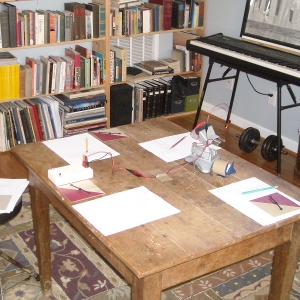
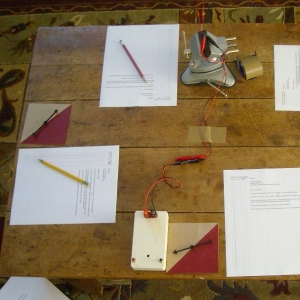
Below are the checklists and instruction sheets given to each participant. Each contains the unique directions for that participant. Click on any to see the full sheet after it was completed: 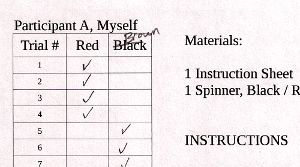
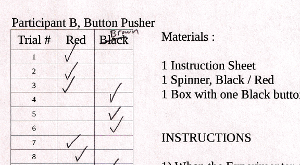
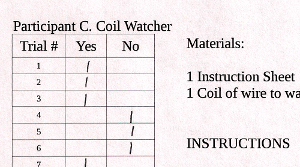
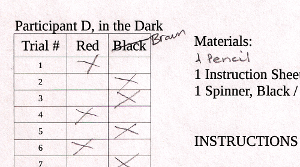
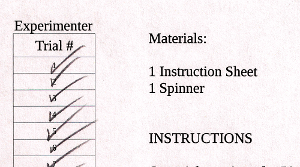
And below is a screenshot of the spreadsheet used to examine the data. More analysis is on the way. Anyone adept with statistics could find much more to say about the data (and I will later on), but the important thing here is that I am testing the hypothesis that it is my willpower against the hypothesis that it is the electric current that causes the observed magnetic attraction. It is not the correlation between my willpower and the observed attraction that matters, but the difference between that and the correlation between the electric current and observed attraction.
|
|
Here are some details of the apparatus for testing the Magnetic Hypothesis, Hmagnetic. I have a copper wire suspended by two flat balsa-wood strips, and they are being held up only by a strip of tape such that the copper wire is free to swing. Wind could cause it to swing. Bumping the table can cause it to swing. Can a wire with electric current flowing through it cause it to swing?
Yes, if there is another conductor. The other conductor is brass or aluminum or copper wire, or the salt water in a pipette. That second conductor is stationary, fixed to the table with clay. The free-to-swing copper wire will be pulled towards the stationary conductor. 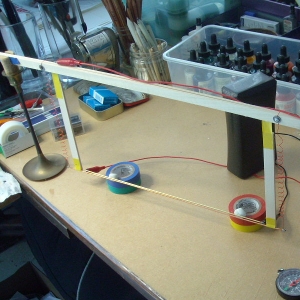
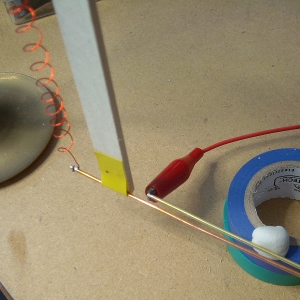
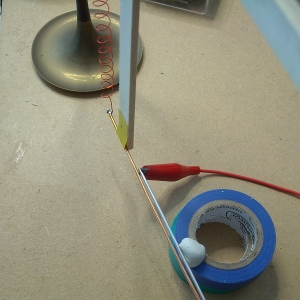
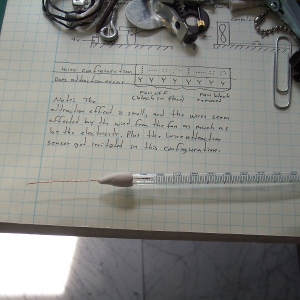
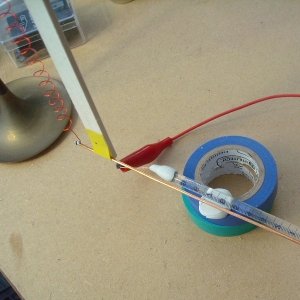
Pipette with salt water In this video you can see that I have the pipette with salt water stationary and I am looking for attraction to the free-to-swing copper wire. What you can't see is that I am pressing and releasing the button in order to get the wire swinging. The effect was very small, so I used that swinging trick to amplify it. Just like pushing someone on a swing, I timmed my button pushing, synchronizing it to the movement. After about 16 seconds I started pressing the button when the wire began to swing away from the glass, and I managed to slow the swing down in the same way I was able to get it swinging in the first place. If you can, open this in a separate video player so you can enlarge it.
|
|
When I started this there were a handful of books on the topic of cognitive biases and the irrational ways of the human mind. Now you can't even count them. This is a vast literature, and I have not pared it down yet even to a shortlist.
In the book I talk about how we are all prone to mistakes in thinking. But sometimes you have to feel it to believe it. If you are overconfident in your own beliefs, but you don't even know how you got those beliefs in the first place, it will be difficult to understand why science has to work the way it does. Have a read or watch some videos or take some online tests: Particularly interesting videos on cognitive fails currently on YouTube:
Books and courses on disk:
Webpages about cognitive fails and fallacies of reason are abundant. So are books pointing out fallacies of reason. The problem with many of these is that they seem to be about how to spot and label bad reasoning in other people. We must first remember that to the other 7 billion people on the planet we are one of the other people.
|
The wrong way to test if the Earth is flat
|